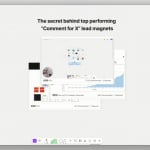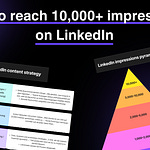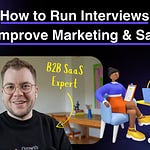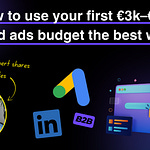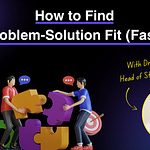Most early-stage founders know Google Ads can drive pipeline — but they’re also terrified of burning budget on useless clicks.
So I asked Adelina Bikeneeva, a SEA expert & freelancer who managed over €1M in Google Ads, how B2B SaaS startups can set up campaigns that actually drive qualified traffic and avoid B2C, bots, and low-quality clicks that just waste sales time.
Here’s what she shared — structured, practical, and straight from the trenches.
New here? Each week, I share practical marketing strategies, tactics and learnings designed to help you scale your B2B business to €1 million ARR and beyond 🚀
Make sure to subscribe to not miss out on any episode!
The 3-Pillar Framework for B2B Google Ads
Adelina structures every campaign around three core pillars:
Deep Research
Tight Campaign Structure
Quality Control + Conversion Feedback Loops
Let’s break each down.
1. Research: Understand Intent and Language (Then Kill the Noise)
Before you run a single ad, you need to:
Understand buyer intent (what high-intent keywords actually signal readiness to buy)
Identify language mismatches (especially across geographies)
Spot and kill B2C traps early
Tools Adelina uses:
Google Keyword Planner
Semrush
Real example: Adelina once worked with a coffee brand targeting offices in Germany and the UK. In Germany, people search for “coffee capsules.” In the UK, they search “coffee pods.” Missing this nuance would’ve killed performance — and wasted budget.
Pro tip: Add keywords like "free", "cheap", "student", "how to", "DIY", and "jobs" to your negative keyword list up front. These are B2C red flags.
2. Structure: Build Clean, Intent-Led Campaigns
Key principles:
Segment campaigns by intent (e.g. consideration vs. direct conversion)
Segment by product (don’t mix offerings in one ad group)
Use exact and phrase match for control — avoid broad match unless you know what you're doing
Also:
Set separate budgets by country — cost-per-click varies massively (e.g., Italy vs. Sweden)
Match your ad copy and landing page exactly to each other to reinforce your targeting intent
Bonus tip: Include B2B signals directly in your copy:
"Enterprise CRM platform"
"Custom pricing for B2B buyers" This helps pre-qualify traffic before they even click.
3. Control Quality with Conversion Feedback Loops
The best campaigns evolve fast — based on real conversion data.
Don’t skip:
Review your search term reports weekly. Kill irrelevant traffic.
Set up offline conversions using your CRM (e.g. HubSpot)
Why offline conversions matter: They tell Google which leads actually turned into pipeline. That makes your bidding smarter — especially with Target CPA strategies.
But here’s the catch: you need volume. If you’re only getting a handful of leads/month, the algorithm won’t learn.
Adelina recommends:
5–10 conversions per week minimum (ideally ~30/month)
Prioritize connecting CRM early, once conversion volume is steady
Extra tips for high-quality conversions:
Use lead scoring in your CRM (e.g. assign values based on job title, company size, ICP match)
Feed only high-scoring conversions back to Google to improve signal quality
Use conversion value rules to tell Google which leads are worth more
Pro tip: When uploading offline conversions, label and segment them (e.g. "Sales Qualified Lead", "Closed Won") so Google learns what really matters.
This level of granularity helps you:
Cut spend on low-value clicks
Focus bidding on high-LTV prospects
Train the algorithm faster with stronger signals
Also worth noting:
Watch for bot traffic or irrelevant spikes, especially if running display or PMAX campaigns — set up filters and tracking to keep quality clean.
Attribution still matters. Use UTM tracking, CRM integration, and Google Ads conversion actions properly tagged to get full-funnel visibility.
Most Overlooked: The Middle of the Funnel
Many founders either:
Run top-of-funnel awareness campaigns (video, brand)
Or jump straight into bottom-of-funnel search ads
But they skip the consideration phase — where buyers are still exploring options.
Fix it with:
Case studies and competitor comparisons
Industry-specific landing pages
YouTube or PMAX campaigns with warm audience signals
Use PMAX the smart way:
Feed it competitor brand names
Add site visitors of similar tools
Use demo watchers or webinar attendees as custom segments
This “warm middle” converts much better than cold outreach — but it’s often ignored.
Example PMAX workflow:
Create a custom segment of users who visited competitor websites
Upload your video testimonials or explainer ads
Point to a landing page that compares you to the competition
Optimize toward micro-conversions (e.g. scroll depth, demo interest)
TL;DR — How to Win at B2B Google Ads (Without Wasting Budget)
Start with deep keyword + intent research — kill B2C terms early
Build lean, segmented campaigns — by intent, product, and country
Use exact/phrase match, never broad unless you're advanced
Feed conversion data back into Google — through your CRM
Don’t skip the middle of the funnel — it’s a goldmine
Use smart copy signals — like "Enterprise" and "Custom pricing" to pre-qualify clicks
Clean your traffic regularly — search terms, negative keywords, attribution paths
If you’re an early-stage B2B founder running Google Ads — or planning to — this is the level of structure and focus that keeps you from burning through budget.
Big thanks again to Adelina for these insights.
Feeling stuck with Google Ads?
Adelina can help you out.
She is a PPC / Performance Marketing Expert and Fractional CMO, helping companies grow and generate leads profitably with her ROI-based method.
Want more hands-on interviews like this? Subscribe to the newsletter and follow me on LinkedIn.
Cheers
Valentin




